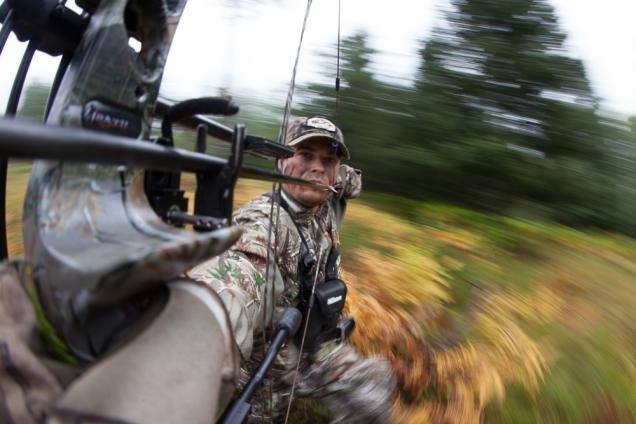30 Aug SURE SHOTS!!!
We had set up along a clear-cut and a forest. The elk were bugling, and moving up the mountain, but would pass the corner, where we waited. Sure enough, as the bull stepped out, my buddy took his shot. The bull ran off with the arrow sticking out along his left side.

After waiting an hour, we began following the blood trail. Within a few hundred yards we found the broken arrow. The blood trail continued but was thinning out. We searched for that bull the rest of the day. After a mile or more, the trail dried up.
I have heard this story many times. Even rifle hunters talk about how the big one got away. In each case, it came down to shot placement. The bow hunters tend to shoot low and the rifle hunters think their mastery of shooting skills are good enough for a head or heart shot. Most aim at the “inzit and not the exit”.
My best advice to kill a BIG critter is know the anatomy of their lungs and heart. Now, aim for where the bullet or arrow will exit the opposite side, and pass through the vitals. AIM FOR THE EXIT!
An adult elk has a kill zone of about 16-18 inches. A deer’s kill zone is 8-10 inches. The lungs are like 2 big, inflated balloons. Pop the balloons and the elk, or buck, is yours. This quick depression will cause immediate shock and death. The problem is that these vitals are also protected with thick hide, muscle, and an internal skeleton. Shoulder blades, ribs, and leg bones can deflect and block the shot. This means that velocity, bullet type and weight, broadhead and shafts, etc. must also be researched and properly addressed.
You need to shoot the balloons dead center. If you are too low, you will catch the brisket, sternum, and non-lethal stuff. Too high and you will spine, muscle, and hide. A low shot could tag the heart. I appreciate a good heart shot but do not target it. You also want a shot where the critter is as 90degrees or broadside as possible. Frontal and rear shots are low percentage shots. Lower shots will produce a better blood trail than a higher shot. My goal is to not need to follow a blood trail.
Now I know that there are bunches of master shooters that disagree with me. My thoughts are based on my hunts, guiding, and stories. Shoot to kill, or you will only take home a story. We have all seen the videos of the Giant Moose being bow shot in Alaska. A HUGE Bull steps out and the arrow immediately drops the bull. How can a shaft and point do that much damage? If the lungs collapse, the critter can’t breathe.
One friend of mine drew a moose tag and used a lever action vintage, under caliber rifle to kill the bull. He found the target and started shooting within 50 yards. 8 shots later the bull was finally down. The neck, head, and face took all the shots. Not one shot was placed through the vitals.
Critters look like they are further away when in thicker cover. This explains high hits. Excitement when shooting always plays a role. No matter how much experience you have, the thrill of the hunt, and shot, are thrilling. A flinch or lifting your head too soon, to see the shot outcome, will cause a miss every time.
Plan your shot before you shoot. The elk’s kill zone is twice as big as a deer. No matter what the distance is, aim for the lower one third of the body. You also want to shoot several inches behind the behind the front leg. If you target the shoulder, you have a good chance of hitting the joint, femur, or scapula. All will non-lethal shots. Too high and you will hit the spine or muscle. Anticipate where your shot will come from and develop a protocol before the shot happens.
The BEST kill shot is 3 inches above and 6 inches behind the elbow of the front leg. If you are low, you will hit the heart. If you are high, you are still in the lungs. Too far left, and you tag the liver. Therefore a light arrow, small caliber, or even a stone pointed arrow from a stick and string bow will do the job.
Anticipate the movement of the critter’s legs. Therefore, some hunters never shoot at an elk or deer when it is moving. Some hunters want to make sure that the animal will go down. They shoot to break the front shoulders. If you are a good enough shot to break the shoulders, you are a good enough shot to make a one shot kill. Do not plan to need a second or 8th shot. One well placed shot is all you need.
Aim for the exit and frame your shot. Imagine that your sight picture is a circle the size of the back to the belly of the critter, and from the front to the back at the same distance. This circle or sight picture is your frame. Center the frame then shoot the middle. Practice this during your prehunting shooting sessions. Think about a framed center, not just a spot.
Since the critter may be above, below, or angled, you must imagine where the arrow, or slug, will exit the critter. The line between you and the exit point must travel through the kill zone. Tree stand hunters must understand this since most of their elevated shots are into small, angled windows.
The worst outcome is to wound or lose your targeted critter. Not only is it a waste, it is unethical. Hunters love what they hunt and hate to see these critters suffer. Fortunately, deer and elk can take a lot of damage and survive. Their blood clots quickly and they are simply tough. We have all seen critters with 3 legs, found broadheads and bullets inside the critter. I remember seeing one elk hunter retrieve a Zwicky broadhead from inside the center of a heart. Some bulls I have helped recover, had several other long-range arrow strikes on their bodies. Losing a critter makes hunters sick.
The key is to practice, practice, practice. You muscle memory must take over when preparing to shoot. This exciting, and fleeting, moment requires your full attention to frame, aim, and time your shot. If you must think about the release, or loading, or a safety, or a scope cover, the moment will be lost.
Sometimes the best shot is to not shoot!
Montana Grant
For more Montana Grant, target him at www.montanagrantfishing.com.


